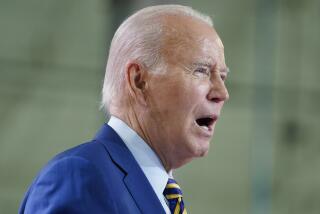House Democrats unveil healthcare reform plan
- Share via
WASHINGTON — Capping months of work, House Democratic leaders on Tuesday introduced their plan for a sweeping remake of the nation’s healthcare system. Among the provisions in the 1,018-page bill: creation of a new government insurance option, increased regulation of the insurance industry and other steps to ensure near-universal medical coverage for the first time in U.S. history.
The bill would also set out new initiatives to begin curbing costs in a healthcare system that is expected to consume nearly $2.5 trillion this year. And the legislation’s more than $1-trillion cost would be offset in part by a new tax on wealthy Americans.
The proposal, among the most liberal of several competing blueprints for revamping the system, drew swift criticism from Republicans and more than 30 business groups, many of which have supported some form of change.
Foreshadowing legislative battles ahead, Sen. Jeff Bingaman (D-N.M.), who has been working on a more moderate version, said, “I don’t think it’s going to go anywhere in the Senate.” But Obama and several liberal groups praised the House proposal.
Here are some of the bill’s major features and the issues they may raise:
--
How will the bill ensure that everyone has health coverage?
For the first time, nearly all Americans would be required to get health insurance or pay a penalty based on their adjusted gross income. Employers would be given an option to provide coverage or pay the government a fee based on 8% of their payroll.
Small businesses with payrolls under $250,000 would be exempt from the fee, which would be phased in for employers with payrolls between $250,000 and $400,000.
Also, new regulations would prohibit insurance companies from denying coverage to people with preexisting medical conditions and from denying coverage for treatments.
All poor Americans making up to 133% of the poverty level would become eligible for Medicaid, which in some states is now limited to families.
Others seeking insurance would be able to shop for plans in a new “exchange” run by the federal government. Private insurers offering insurance on the exchange would have to offer a standard benefit package designed by the government.
In addition, a new government insurance program would be offered, to be financed with premiums paid by customers. The new government plan initially would pay hospitals and doctors slightly more than Medicare rates.
People making between 133% and 400% of the federal poverty line -- roughly $29,300 to $88,200 for a family of four -- would be eligible for credits to help them buy insurance.
--
Will everyone be covered?
The nonpartisan Congressional Budget Office, which is analyzing the bill, estimates that 97% of Americans and legal immigrants would have health coverage by 2019.
The CBO also estimates that approximately 162 million would continue to get their insurance from their employers (up from 150 million in 2010). The office projects that 30 million people would get coverage through the new exchange, of which 9 million would choose the new government program.
--
How will the bill lower costs and improve quality for those who have coverage?
The government would set up pilot programs to reward doctors and hospitals that do more to coordinate care, a step many experts say is crucial to reducing unnecessary treatment.
The government would also begin paying more to primary care physicians, expanding funding for prevention programs and rewarding private insurers contracting with Medicare that can demonstrate their patients receive better care.
Critics contend that these steps do not guarantee that Americans will see their medical bills go down any time soon.
--
How will it all be paid for?
House Democrats envision raising about $544 billion over the next decade with a graduated surtax on high-income families and individuals.
Joint filers with adjusted annual gross incomes between $350,000 and $500,000, and individual taxpayers with adjusted gross incomes between $280,000 and $400,000, would pay an additional 1% income tax.
Joint filers making between $500,000 and $1 million and individual filers making between $400,000 and $800,000 would pay an additional 1.5% income tax.
And joint filers making more than $1 million and individuals making more than $800,000 would pay an additional 5.4% income tax.
--
What happens now?
This week, the bill will be debated by three House committees, where lawmakers will try to amend it. House leaders hope to bring the legislation to the floor for a vote before the August recess.
It would then have to be reconciled with whatever emerges from the Senate, where lawmakers are at work on two different healthcare bills.
The Senate may not finish work on its legislation before August, making reconciliation with the House unlikely before September, at the earliest.
--
More to Read
Get the L.A. Times Politics newsletter
Deeply reported insights into legislation, politics and policy from Sacramento, Washington and beyond. In your inbox twice per week.
You may occasionally receive promotional content from the Los Angeles Times.










